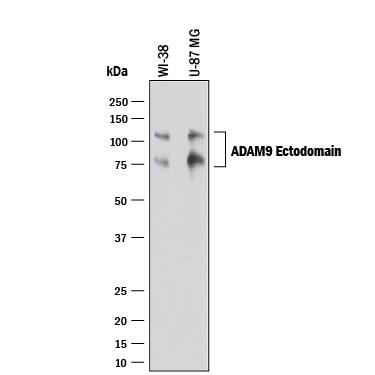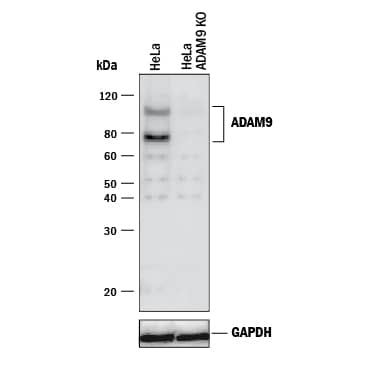Human ADAM9 Ectodomain Antibody
R&D Systems, part of Bio-Techne | Catalog # AF939


Key Product Details
Validated by
Species Reactivity
Validated:
Cited:
Applications
Validated:
Cited:
Label
Antibody Source
Product Specifications
Immunogen
Ala206-Asp697
Accession # Q13443
Specificity
Clonality
Host
Isotype
Scientific Data Images for Human ADAM9 Ectodomain Antibody
Detection of Human ADAM9 by Western Blot.
Western blot shows lysates of WI-38 human lung fibroblast cell line and U-87 MG human glioblastoma/astrocytoma cell line. PVDF membrane was probed with 1 µg/mL of Goat Anti-Human ADAM9 Ectodomain Antigen Affinity-purified Polyclonal Antibody (Catalog # AF939) followed by HRP-conjugated Anti-Goat IgG Secondary Antibody (Catalog # HAF017). Specific bands were detected for ADAM9 at approximately 110 and 80 kDa (as indicated). This experiment was conducted under reducing conditions and using Immunoblot Buffer Group 1.Western Blot Shows Human ADAM9 Specificity by Using Knockout Cell Line.
Western blot shows lysates of HeLa human cervical epithelial carcinoma parental cell line and ADAM9 knockout HeLa cell line (KO). PVDF membrane was probed with 1 µg/mL of Goat Anti-Human ADAM9 Ectodomain Antigen Affinity-purified Polyclonal Antibody (Catalog # AF939) followed by HRP-conjugated Anti-Sheep IgG Secondary Antibody (Catalog # HAF016). Specific bands were detected for ADAM9 at approximately 78 and 110 kDa (as indicated) in the parental HeLa cell line, but is not detectable in knockout HeLa cell line. GAPDH (Catalog # AF5718) is shown as a loading control. This experiment was conducted under reducing conditions and using Immunoblot Buffer Group 1.Applications for Human ADAM9 Ectodomain Antibody
Immunoprecipitation
Sample: Conditioned cell culture medium spiked with Recombinant Human ADAM9 (Catalog # 939‑AD), see our available Western blot detection antibodies
Knockout Validated
Western Blot
Sample: WI‑38 human lung fibroblast cell line and U‑87 MG human glioblastoma/astrocytoma cell line
Human ADAM9 Sandwich Immunoassay
Formulation, Preparation, and Storage
Purification
Reconstitution
Formulation
Shipping
Stability & Storage
- 12 months from date of receipt, -20 to -70 °C as supplied.
- 1 month, 2 to 8 °C under sterile conditions after reconstitution.
- 6 months, -20 to -70 °C under sterile conditions after reconstitution.
Background: ADAM9
ADAM9, also known as MDC9 or meltrin gamma, is a member of the ADAM family that contains a disintegrin and metalloprotease-like domain (1). Like other membrane-anchored ADAMs, ADAM9 consists of a pro domain with a cysteine switch and furin cleavage sequence, a catalytic domain with the zinc-binding site and Met-turn expected for reprolysins, a disintegrin-like domain, a cysteine-rich domain, an EGF-like domain, a transmembrane domain, and the cytoplasmic domain. ADAM9 is able to cleave peptides corresponding to cleavage sites of tumor necrosis factor-alpha (TNF-alpha), the p75 TNF receptor, the beta-amyloid protein precursor, and the c-kit ligand-1, implying that it may participate in shedding of these membrane proteins (2). In fact, ADAM9 has been shown to shed membrane-anchored heparin-binding EGF-like growth factor (3). In addition, it also cleaves oxidized insulin beta-chain and fibronectin (2,4). Besides its catalytic activity, ADAM9 functions as an adhesion molecule through binding of its disintegrin domain to integrins such as alphav beta5 and alpha6 beta1 (5, 6). The cytoplasmic domain of ADAM9 interacts with Src homology 3 (SH3)‑containing proteins and protein kinase C, and may mediate different signaling pathways (3, 7). ADAM9 is widely expressed in tissues (8).
References
- Moss, et al. (2001) DDT 6:417.
- Roghan, et al. (1999) J. Biol. Chem. 274:3531.
- Izumi, et al. (1998) EMBO J. 17:7260.
- Schwettmann and Tschesche (2001) Prot. Expre. & Purif. 21:65.
- Nath, et al. (2000) J. Cell Sci. 113:2319.
- Zhou, et al. (2001) Biochem. Biophys. Res. Comm. 280:574.
- Howard, et al. (1999) J. Biol. Chem. 274:31693.
- Weskamp, et al. (1996) J. Cell. Biol. 132:717.
Long Name
Alternate Names
Gene Symbol
UniProt
Additional ADAM9 Products
Product Documents for Human ADAM9 Ectodomain Antibody
Product Specific Notices for Human ADAM9 Ectodomain Antibody
For research use only
